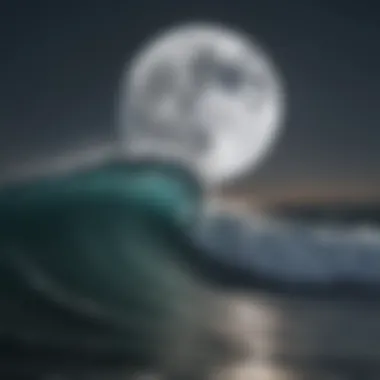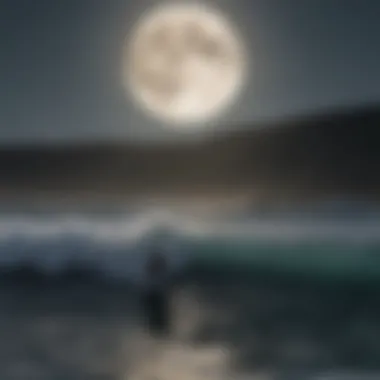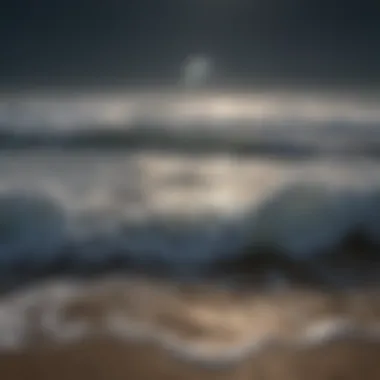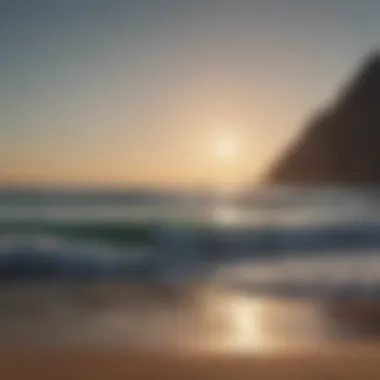Moon Phases and Their Impact on Surfing


Intro
The relationship between moon phases and ocean behavior is intricate and significant. For surfers and ocean enthusiasts, understanding these phases can greatly influence their experiences on the water. Each lunar phase affects tidal patterns and surf conditions. By comprehending these elements, surfers can make informed choices about when and where to catch waves.
In this article, we will delve into the science behind moon phases, their impact on the ocean, and practical insights beneficial for those who enjoy surfing. From exploring various surfboarding techniques to knowing how different moon phases alter tide dynamics, this comprehensive guide provides valuable information for every surf aficionado.
Ultimately, understanding moon phases goes beyond just curiosity; it presents an opportunity to enhance water adventures and optimize surfing outcomes.
Preamble to Moon Phases
The moon has a profound effect on our planet. While many are aware of its role in influencing minimal aspects of daily life, fewer recognize how significant the moon phases can be for activities such as surfing. Understanding these phases is not merely an academic pursuit; it holds practical implications for those who spend time on the ocean. Surfing enthusiasts are particularly affected. The correlation between lunar cycles, tidal movements, and ocean behavior cannot be overlooked. This article aims to bridge the gap between celestial events and marine activities, providing surfers with knowledge to enhance their water experiences.
Definition of Moon Phases
Moon phases are the distinct stages of the moon's visibility as observed from Earth. These phases result from the moon's position relative to the Earth and the sun. They consist of several key stages: new moon, first quarter, full moon, and last quarter. Each of these stages lasts about 29.5 days, collectively making up a lunar cycle. During a new moon, the moon is positioned between the Earth and the sun, making it invisible. Conversely, during a full moon, the Earth is between the sun and the moon, resulting in a fully illuminated moon. Such differences affect not only the view in the sky, but also behaviors in the ocean.
Historical Perspectives
Historically, ancient civilizations closely monitored moon phases for various activities, including agriculture and navigation. The tides influenced by the moon have been observed by humans for millennia. For example, fishing communities relied on known tidal patterns associated with lunar phases to optimize their catch. Similarly, sailors used lunar insights for navigating oceans more safely and effectively. Such historical reliance on moon phases underscores the importance of understanding these cycles. Contemporary surfers can benefit from this long-standing knowledge, enhancing their approach to water sports while being mindful of the natural forces at play. This connection between historical comprehension and modern practice lays the groundwork for effective surfing strategies.
The Science Behind Moon Phases
The study of moon phases is not just an abstract concept; it is a crucial element that influences many natural phenomena on Earth. Recognizing how moon phases affect surfing and ocean behavior allows surfers to make informed decisions, optimizing their time on the water. Explaining the science behind these lunar phases illuminates how gravity and light play roles in shaping ocean tides and surf conditions. Understanding this scientific foundation provides surfers with an opportunity to harness the ebb and flow of the ocean to enhance their experiences.
Lunar Orbit and Its Effects
The moon's orbit around the Earth is elliptical, creating variations in its distance from our planet. This distance plays a significant role in the gravitational pull exerted by the moon. When the moon is closer, during the perigee phase, its gravitational influence is stronger, leading to more pronounced tidal effects. This can create exceptional conditions for surfing, as larger waves often accompany spring tides that occur during new and full moons.
In contrast, when the moon is farther away, during apogee, tides tend to have less strength. For surfers, this means that the wave dynamics and surf conditions may not be as robust. The subtleties of these changes can directly impact wave size and frequency, making it critical for surfers to be aware of the moon's positioning in its cycle.
Light Reflection and Visibility
The reflection of sunlight off the moon also modifies the surfing environment. Different phases of the moon result in varying levels of luminosity at night. For instance, a full moon creates bright conditions, which can dramatically influence visibility while surfing at night. Surfers may favor full moon nights for evening sessions, as visibility is optimal, allowing them to navigate more safely.
Conversely, during the new moon phase, the absence of moonlight can create darker conditions, making night surfing less appealing. Waves in the dark may also cause disorientation for some surfers. Thus, understanding the moon's light reflection is essential for planning the best surf sessions, whether at dawn or dusk.
"The moon's cycles not only dictate the tides but also shape the very environment in which surfers ride those waves."
In summary, the lunar orbit and the moon’s light reflection are fundamental aspects of understanding how moon phases influence surfing. Surfers equipped with this knowledge can plan their outings more efficiently, taking advantage of optimal conditions tailored to the lunar calendar.
Major Moon Phases
The phases of the moon play a crucial role in various aspects of ocean behavior and surfing. Specifically, understanding these phases allows surfers to anticipate changes in tide patterns, surf conditions, and marine life. Each moon phase carries unique characteristics that can significantly impact the water's behavior, making knowledge of these phases essential for an athlete looking to enhance their surfing experience.
New Moon


Significance in Surfing
During the new moon phase, the moon is positioned between the Earth and the sun. This positioning results in less visible moonlight and, as such, may create a more tranquil atmosphere in ocean waters. For surfers, this phase often means that the swells can be more consistent, making it a good time for wave riding. The lower visibility may not deter surfers but can lead to improved focus as they ride.
The absence of light also means less interference from other environmental factors, which leads to a clearer and sometimes more predictable surfing experience. This moment is considered beneficial for surfers seeking both challenge and enjoyment in their sport.
Impact on Tides
The influence of the new moon on tides is significant. As gravity acts strongly during this phase, it results in what are known as spring tides. These tides create exaggerated high and low water levels, affecting how water interacts with the shoreline. Surfers often find that the stronger the tides, the better the conditions for certain types of waves. Understanding this dynamic can lead surfers to choose times when they might experience either larger swells or ideal low-tide conditions—a factor that can enhance their overall surfing strategy.
First Quarter
Surf Conditions
The first quarter phase occurs when half of the moon is illuminated. This phase generally leads to moderate surf conditions. The waves are often less intense compared to the full moon or new moon, which can be favorable for novice surfers or those looking for a more relaxed experience. The moderate conditions can also provide an opportunity for surfers to practice and refine their skills without facing overwhelming waves.
On the flip side, the wave size can sometimes lead to disappointment for advanced surfers looking for an adrenaline rush. Recognizing this, surfers must gauge surf reports and tide times carefully during this phase.
Behavioral Changes in Marine Life
The first quarter is also notable for its influence on marine life behavior. Fish and other aquatic creatures may be more active as they take advantage of the changing tides. This increased activity can enhance the overall surf experience, as it provides opportunities for surfers to observe marine environments more closely. By understanding these behaviors, surfers can plan their trips to coincide with peak activity times, creating a richer experience.
Full Moon
Tidal Extremes
The full moon phase brings about the most dramatic tidal changes. Known for creating the highest and lowest tides, this phase can lead to extreme conditions in the surf. Surfers often find that larger swells appear during this time due to the increased gravitational pull. This can make for some of the best riding opportunities. However, the increased intensity also means that only experienced surfers should tackle these conditions.
It's essential to monitor local reports during a full moon to find the optimal times to surf. Thus, while the chances for spectacular waves are high, surfers must also be cautious of the powerful surf conditions.
Best Surfing Opportunities
With conditions often peaking during the full moon, surfers typically flock to the water during this phase. The heightened swell conditions can lead to thrilling surfing experiences, making it a favorite among seasoned surfers. However, new surfers may struggle to adapt to such variables, necessitating an understanding of he local breaks at this time.
Engaging with tide charts and local surf reports can empower surfers to maximize their opportunities when planning their surf sessions during a full moon.
Last Quarter
Wave Patterns
The last quarter moon brings with it a unique set of wave patterns. As the moon begins to wane, the ocean's behavior changes once more. Surfers often note that the waves can become less consistent but might experience fun, rolling swells on certain days. Recognizing these patterns can lead to surprising and enjoyable surfing experiences.
Surfers should remain vigilant when tracking these patterns, as local conditions (beach structure, weather, etc.) can significantly affect how the waves behave during this phase.
Potential Challenges for Surfers


As the last quarter leads to diminishing tides, surfers can face potential challenges. The less predictable conditions can make it hard to find the right waves. New surfers, in particular, might find frustration if they do not adjust their expectations. Therefore, an adept ability to read conditions and adapt to varying wave situations is crucial when handling the complexities presented during the last quarter phase.
Lunar Influence on Ocean Behavior
The topic of lunar influence on ocean behavior is crucial for understanding the interaction between moon phases and marine activities, especially surfing. The moon's gravitational pull affects tides which, in turn, impact surf conditions. A surfer's ability to predict these changes can be an asset for choosing the ideal moments for catching waves. Understanding tides is more than just knowing when to surf; it helps in comprehending the broader dynamics of ocean behavior that influence not only surf conditions but also marine life health and activity.
Tides Explained
The concept of tides is a fundamental aspect of ocean behavior, directly related to the gravitational forces exerted by the moon and the sun.
Gravity's Role
Gravity is a primary force in the creation of tides. The moon's gravitational pull generates bulges in the ocean, resulting in high and low tides. As the moon orbits the Earth, these bulges shift, which causes the water levels to change cyclically. This essential characteristic of gravity explains why understanding tide patterns is beneficial for surfers. Surfers can time their sessions to coincide with high tides for better wave quality or low tides to avoid crowded beaches. The unique feature of this gravitational influence is its predictability. Tide tables are based on mathematical models that take into account both gravitational forces and lunar cycles. Lacking knowledge of tidal effects may lead to missed opportunities or unfavorable conditions.
"Understanding tides is essential for surfers aiming to optimize their ocean adventures."
Spring Tides vs. Neap Tides
Spring tides and neap tides represent contrasting tidal amplitudes, which affect surfing conditions differently. Spring tides occur when the sun, moon, and Earth align. This alignment produces larger tidal swings. The significant characteristic of spring tides is their ability to create optimal surf conditions due to higher wave energy. On the other hand, neap tides occur when the moon is at a right angle to the sun. This results in smaller tidal ranges and less favorable surf conditions.
The unique feature of spring tides allows surfers to ride bigger waves during the peak of the tidal action, thus enhancing their experience. However, neap tides might inadvertently benefit other water activities like snorkeling. Knowing when these tides happen helps surfers plan better and manage their expectations regarding wave quality and behavior.
Impact on Surf Conditions
The tidal cycle significantly impacts surf conditions, affecting wave consistency and the overall surfing experience.
Consistency of Waves
Wave consistency refers to how regular and predictable the surf conditions are. This aspect is directly influenced by tides, which shape wave formations along coastlines. Often, higher tides can produce more consistent waves as water depth increases. This increases the likelihood of good surf sessions. Apart from the immediate surf conditions during a tide, the moon phase also guides long-term surfing plans. Experienced surfers identify patterns in wave consistency tied to lunar cycles. This understanding aids in strategically choosing when to go surfing, thus optimizing performance.
Timing Surf Sessions
The timing of surf sessions is vital for achieving the best results on the water. Knowledge of the tidal schedule, along with the current moon phase, can significantly enhance a surfer’s experience. This key characteristic allows surfers to plan sessions for optimal conditions, maximizing the potential for catching great waves. Surfing right before or after a tide change usually leads to the best surfing conditions, as the shifting water can generate the desired waves.
The unique feature of this timing approach includes utilizing local tide charts for each surf spot. This not only informs the surfer of when to enter the water but provides them an understanding of when to exit to avoid unfavorable conditions. Therefore, comprehending both tide-related timing and lunar cycles becomes indispensable for any dedicated surfer.
Utilizing Moon Phases for Surfing Success
Understanding how to effectively utilize moon phases can significantly enhance surfing experiences. The connection between lunar cycles and ocean behavior is undeniable. Surfing enthusiasts can reap multiple benefits by being mindful of these celestial events. An awareness of how moon phases affect tides, wave patterns, and overall ocean behavior can lead to more productive days on the water.
Planning Surf Trips
Choosing Optimal Times
Choosing optimal times for surfing is critical for maximizing wave quality. Timing around specific moon phases can lead to better surf conditions. During the full moon and new moon, tides tend to be more pronounced. This results in stronger waves, and can transform otherwise placid beaches into ideal surf spots. Surfers often gravitate towards these times, making them popular. Planning a surf trip around these phases can be a beneficial approach for anyone looking to catch the best waves.


Unique Features
The full moon phase brings significant tidal shifts, resulting in either high or low tides that can impact wave forms. The unique advantage is the opportunity for larger surf and, at times, increased crowd sizes. As such, surfers should prepare for both amplified conditions and potential competition on the waves.
Location Awareness
Location awareness is another aspect that cannot be understated. Different coastlines react differently to lunar cycles. Certain regions might offer better surf during specific moon phases while others experience challenging conditions. Observing local tide charts influenced by lunar phases is essential about decision-making. This awareness can ensure surfers pick regions most conducive for surf sessions.
Advantages and Disadvantages
The advantage of being aware of where to surf is the potential for consistent wave quality and optimized surf sessions. However, the challenge can be identifying the right times and locations, especially for beginners. Thorough research and planning are necessary to gain an edge.
Maintaining a Lunar Calendar
Tracking Phases
Tracking phases of the moon serves as a practical guide for surfers. With a lunar calendar, surfers can monitor lunar activity and forecast potential waves. This practice allows surfers to stay informed on upcoming phases affecting tides. By knowing when specific phases occur, surfers can strategize their surfing sessions more effectively.
Importance
Tracking phases has gained popularity among surfers who want to ensure they are surfing at the right times. It often leads to more rewarding experiences, as surfers can plan ahead and even adjust schedules based on anticipated ocean behavior.
Monthly Surf Predictions
Monthly surf predictions can be combined with lunar tracking to gain insights into potential surf conditions. By analyzing past data correlated with moon phases, surfers can estimate wave performance in various locations for the upcoming month.
Characteristics
These predictions can be invaluable for dedicated surfers. They help in decision-making regarding which days are likely to offer the best experiences on the water. Thus, having this knowledge can take surfing preparation to a higher level.
"Understanding the moon's role in ocean behavior not only improves surf odds but can transform the overall experience on the water."
In summary, utilizing the moon phases effectively ties into the art and approach of surfing. From carefully planned trips considering optimal times and local conditions to maintaining awareness of lunar activities, surfers can truly enhance their experience. The key is to remain attentive to how these celestial influences shape the ocean, ultimately influencing surf conditions.
Ending
In this article, we have explored the vital relationship between moon phases and their significant effects on surfing and ocean behavior. Understanding these lunar cycles can greatly benefit surfers and other ocean enthusiasts. By recognizing how each phase impacts tidal patterns and surf conditions, surfers can make informed decisions that enhance their overall experience on the water. The importance of knowing the full spectrum of moon phases cannot be understated. Each phase plays a unique role in shaping the behavior of oceans and influencing wave formations.
Recap of Key Insights
Throughout this discussion, we highlighted several critical points:
- Lunar Influence: Various moon phases create distinct tidal shifts, enabling surfers to identify optimal surfing times.
- Tidal Mechanics: Knowing the difference between spring tides and neap tides helps surfers understand when to expect the best conditions.
- Planning Surf Sessions: Timing surf trips in accordance with moon phases can maximize wave quality and consistency.
Gaining insight into these elements allows surfers to refine their approach to the sport. Every phase presents its own set of opportunities and challenges that can be leveraged for a more satisfying experience.
Encouragement for Mindful Surfing
Mindful surfing is not just about riding the waves; it encompasses understanding the ocean's behavior informed by lunar cycles. Surfers should consider keeping a lunar calendar to track those phases and tide changes. By doing so, they can schedule their outings accordingly, minimizing missed opportunities for great waves. Moreover, the practice of being attuned to environmental elements encourages a deeper connection between surfers and the ocean.
"Understanding the subtleties of nature can transform your surf experience, leading to greater enjoyment and respect for the marine environment."







